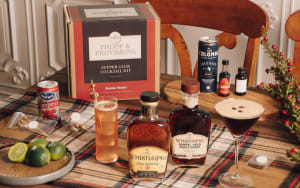Buffalo Trace Distillery, a renowned bourbon producer in Frankfort, Kentucky, has bounced back from a challenging period of flooding that forced a temporary closure. In early April 2025, heavy storms caused the Kentucky River to overflow, submerging parts of the distillery’s campus and nearby Wilkinson Boulevard. The flooding, which began impacting the area significantly by April 6, caused substantial damage to buildings and disrupted operations at the historic distillery. However, thanks to the dedication of the distillery’s team and contractors, Buffalo Trace has made remarkable strides in its recovery, resuming bottling operations and partially reopening to visitors by mid-April.
The distillery, famous for crafting premium bourbons like Blanton’s, Pappy Van Winkle, Weller, Stagg, and Elmer T. Lee, faced a weeklong shutdown after floodwaters inundated the facility. On April 15, Buffalo Trace announced that it had resumed bottling operations, including craft bottling in the Blanton’s Bottling Hall and activities in the main bottling hall. This milestone came after tireless efforts to clear more than 75% of the floodwater debris and restore power to critical areas of the distillery. Jake Wenz, the CEO and president of Sazerac and Buffalo Trace Distillery, praised the team’s resilience, noting that their hard work was instrumental in getting operations back on track. He expressed optimism that the distillery would soon return to full normalcy, stating that significant progress was being made daily.
The flooding posed a unique challenge for Buffalo Trace, which is in the midst of a massive $1.2 billion, 10-year expansion project. This ambitious initiative has already boosted the distillery’s production capacity from 200,000 barrels annually to over 500,000, making it one of the largest bourbon producers in the world. Despite the scale of the flood damage, the distillery’s leadership remained focused on maintaining the quality and integrity of its products. Harlen Wheatley, Buffalo Trace’s master distiller, emphasized the team’s commitment to carefully inspecting every barrel that may have been affected by the floodwaters. The inspection process, which began on April 10 and is expected to take several weeks, ensures that no compromised barrels make it into the final product. Wheatley stressed that the distillery would never sacrifice the quality or safety of its whiskey, reflecting the care and dedication that goes into every bottle.
In addition to resuming bottling, Buffalo Trace took steps to welcome back visitors, albeit in a limited capacity. Starting April 14, the distillery opened a modified retail experience for guests with existing tour reservations. This included a small pop-up shop inside the Freehouse building, where visitors could purchase select bottles, and an outdoor canopy offering complimentary tastings. Unlike normal operations, walk-up visitors were not permitted, and access was restricted to those with confirmed bookings. The distillery noted that additional reservations might be made available online if capacity allowed, encouraging eager fans to stay tuned for updates. This cautious approach reflects Buffalo Trace’s commitment to balancing visitor enthusiasm with the practical limitations of its ongoing recovery.
The flooding not only affected the distillery but also had a broader impact on the Frankfort community. Buffalo Trace acknowledged the support of local contractors and team members who worked tirelessly to address the damage. In a gesture of goodwill, the distillery announced plans for relief initiatives to support the surrounding community, though specific details were not yet available. For those looking to contribute, Buffalo Trace directed people to the Franklin County Flood Relief Fund, managed by the Blue Grass Community Foundation, as a way to help those affected by the floods.
While the flooding posed a significant setback, Buffalo Trace’s leadership remains confident that the impact on its bourbon production will be minimal. The distillery reported that any potential loss of barrels due to floodwater exposure is not expected to be significant. This assurance is critical for fans of Buffalo Trace’s sought-after bourbons, which are known for their craftsmanship and limited availability. The distillery’s ability to quickly resume bottling and reopen to visitors highlights its resilience and operational strength, even in the face of natural disasters.
As Buffalo Trace continues its recovery, the distillery’s story serves as a testament to the determination and teamwork that define Kentucky’s bourbon industry. From the meticulous inspection of barrels to the phased reopening of visitor experiences, every step reflects a commitment to excellence and community. For bourbon enthusiasts, the news of Blanton’s and other premium bourbons being bottled once again is a welcome sign that Buffalo Trace is back in action, ready to continue its legacy as a cornerstone of American whiskey production.




